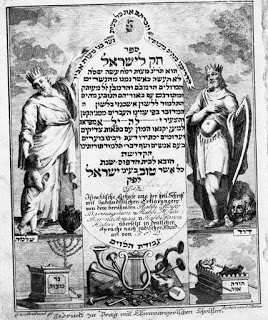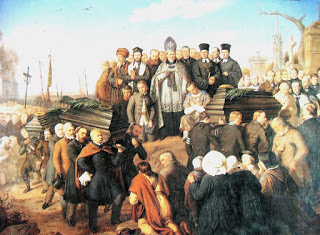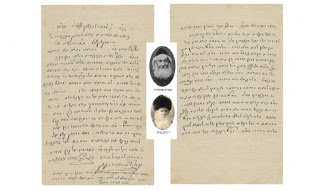Genazym Auctions: Illustrations & the Friendship Between the Hazon Ish and R. Zevin
Genazym Auction: Illustrations and the Friendship between the Hazon Ish and R. Zevin
The auction house, Genazym, is holding its third auction (the catalog is available here) this week Thursday, August 30th. This auction includes many Hassidic works, letters, autographs, early editions, and some impressive bindings. Additionally, as at other auction houses, items are already appearing from the Lunzer/Valmadonna collection whose books were sold and auctioned in the past year.
There are a few items that have aspects that go beyond their texts. The book, Hok le-Yisrael, Prague, 1798, (lot 27) is notable for its unusual title page. It contains Dovid and Shlomo (for a discussion of the inclusion of biblical figures on the title-page see here), with the head of Goliath at David’s feet. David is shown lifting his shirt to expose his belly which is depicted as one of substantial girth. It is unclear why the illustrator used that particular pose. The remainder of the illustration is unremarkable. But the text of the title has its own quirk, where it is printed in a handwritten font, both the Hebrew and the German.
Just to mention one other unique illustrated item I recently came across about to be auctioned off in the forthcoming Genazym auction (lot 26). In a few copies of the 1840 printing of the classic work on Shecitah, Tevous Shor there is a very nice illustration connected to the title and name of the author.
Some books are especially valued because of their legendary segulah powers. Recently this has become even more commonplace with this genre expanding exponentially.[1] At times the source for how these books fall into that genre are murky, but one that has a long history is Hayim ben Attar’s Or ha-Hayim. The first edition, Venice 1742, (lot 49), in a very nice binding, is highlighted for its segulah powers that include protection, healing, and children, and the study of it has the power to purify one’s soul.
Returning to illustrations, a portrait of R. Dov Ber Meisles, the rabbi of Warsaw (and other cities), from 1891, is among the items. This is not the only illustration that R Meisels appears. During the late 1860s, there was substantial unrest in Poland when many sought to force the Tsar to bestow greater civil rights to the populace. The clergy played a large role in this endeavor and R Meisels was among them. This was viewed as an opportunity for Jews to be accepted by the population. In this, Meisels had a profound impact and was among the main influencers of Marcus Jastrow to take part in the movement. Meisels and Jastrow became very close. When both were imprisoned for their activities, initially Jastrow was kept in isolation but when he was transferred to Meisels’ cell, Jastrow’s spirits were lifted and was able to deal with the remainder of his imprisonment. In the end, both were expelled from Poland, although eventually permitted to return. One of the most notable events during this period was the funeral of five protesters who were killed by government forces. The funeral took place on Shabbos and both Jastrow and Meisles were in attendance. Their participation is recorded in Aleksander Lesser’s painting, “Funeral of five victims of the demonstration in Warsaw in 1861.”In the center left, Meisels appears with a fur hat next to Jastrow in his canonicals.[2]
Another item of ephemera is a letter from the Hazon Ish to R. Yosef Zevin (lot 68)(the envelope confirms that the addressee was R Zevin). Although there is no doubt about R Zevin’s Zionist leanings, the Hazon Ish carried on a correspondence with him.[3] This is yet another letter showing the connection between R Zevin and the Hazon Ish. (For others, see Yehoshuah Levin, HaShakdan (Monsey: Tuvia’s, 2010), 117). R Zevin included a profile of Hazon Ish and his style of study in the book Ishim ve-Shitot.
As we have shown in the past, one can learn all kinds of things from the information found in the writeups in the various auction catalogs including seeing actual clear copies of the manuscripts (lot 55). there is a letter of his from 1886 about his essay on Antisemitism called Shar Yisroel which he was about to print. He writes to his son to check it over as someone told him that perhaps some might get angry about and it would cause problems for him and the Yeshiva. This is not the only time that we find the Netziv nervous about his actions and that it would cause possible problems for the Yeshiva.
Two of R Yaakov Emden’s important works, Mitpahat Seforim and his Siddur, both of which are rare are up for sale (lots 75 & 76). The first of edition of his siddur is critical to actually determining R. Emden’s opinions regarding the liturgy and its attendant customs. This is so because although there are many alleged reprints of the Siddur, they, in fact, do not include the text that R Emden so carefully edited. Only recently has the complete siddur been reprinted. The Mitpahahat is R Emden’s well-known challenge to the Zohar, or parts of it. Emden points to many passages that appear to be later than when R Shimon bar Yochi lived, the traditional author of the Zohar. R. Emden’s work was subject to some rebuttals, one is Moshe Kunitz Ben Yochi. But some allege that Kunits freely borrowed from others and that his rebuttals fall short of the mark.
One final item, also a siddur, is a first edition of Siddur R’ Shabsai MeiRushkov (lot 95) which is considered very rare starting bid is $50,000 and with a sale’s estimate of $100,000.
[1] See Avraham Ya’ari, Mehkeri Sefer (Jerusalem: Yehuda, 1958) who discussed a number of books that were written after the author experienced cataclysimic events. See also Eliezer Brodt’s article in the forthcoming Ami Magazine discussing the ubiquity of this phenomenon.
[2] See Jastrow, “Baer Meisels, Chief Rabbi,” The Maccabean XI, 5 (Nov. 1906), 208-09; idem. XI, 6 (Dec. 1906), 246-48. For Jastrow’s activities during that time see Michael Galas, Rabbi Marcus Jastrow and His Vision for the Reform of Judaism: A Study in the History of Judaism in the Nineteenth Century, trans. Anna Tilles (Boston: Academic Studies Press, 2013), 70-88. Even at the end of his life, Jastrow was in America he still counted Meisel among those who influenced him. See idem. 170.
[3] That is not to say that some didn’t try to write out R Zevin’s connection to Zionism. See Jacob J. Schacter, “Facing the Truths of History,” Torah u-Madda Journal 8 (1998-1999): 223-24.



